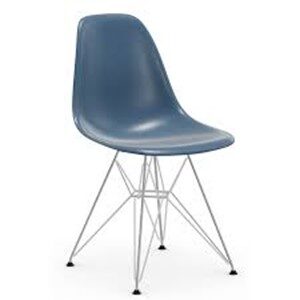 The Advocate-General’s opinion in the Kwantum v. Vitra referral is remarkable in several ways. The case concerns the protection under Dutch copyright of the iconic “DSW” chair designed by American designers Charles and Ray Eames. Kwantum, a popular low-budget furniture store chain, sold copies of the chair without rightholder Vitra’s permission. Before the Dutch courts the case turned on the interpretation of Article 2(7) of the Berne Convention – an exception to Berne’s ground rule of national treatment. According to Article 2(7) the designer of a work of applied art that originates in a BC country where such works are not eligible for copyright (but solely for special design protection), is not entitled to copyright protection in other Berne states. The logic behind this provision is the lack of international consensus on the protection of works of applied art. While the European Design Protection Directive and Regulation require EU Member States to apply copyright and design right cumulatively, several countries outside Europe exclude or severely restrict copyright protection of industrial designs. One such country is the United States. According to US copyright law, the design of a so-called “useful article” may be copyrighted only insofar as its aesthetic aspects are separable from is utilitarian features. The policy rationale behind Article 2(7)’s reciprocity rule is to prevent countries like the US from asymmetrically benefiting from copyright protection in other states. Indeed, the US useful article doctrine combined with Article 2(7) BC has made it difficult if not impossible for American designers to rely on copyright protection in EU states.
The Advocate-General’s opinion in the Kwantum v. Vitra referral is remarkable in several ways. The case concerns the protection under Dutch copyright of the iconic “DSW” chair designed by American designers Charles and Ray Eames. Kwantum, a popular low-budget furniture store chain, sold copies of the chair without rightholder Vitra’s permission. Before the Dutch courts the case turned on the interpretation of Article 2(7) of the Berne Convention – an exception to Berne’s ground rule of national treatment. According to Article 2(7) the designer of a work of applied art that originates in a BC country where such works are not eligible for copyright (but solely for special design protection), is not entitled to copyright protection in other Berne states. The logic behind this provision is the lack of international consensus on the protection of works of applied art. While the European Design Protection Directive and Regulation require EU Member States to apply copyright and design right cumulatively, several countries outside Europe exclude or severely restrict copyright protection of industrial designs. One such country is the United States. According to US copyright law, the design of a so-called “useful article” may be copyrighted only insofar as its aesthetic aspects are separable from is utilitarian features. The policy rationale behind Article 2(7)’s reciprocity rule is to prevent countries like the US from asymmetrically benefiting from copyright protection in other states. Indeed, the US useful article doctrine combined with Article 2(7) BC has made it difficult if not impossible for American designers to rely on copyright protection in EU states.
In a move that surprised both parties to the Dutch proceedings and the Dutch Advocate General, the Supreme Court of the Netherlands decided to stay the proceedings and ask questions to the CJEU. Inspired by the CJEU’s RAAP decision, which held that EU law does not allow a Member State to deny remuneration rights to artists and record producers, based on a reservation clause in the WPPT but without a clear legal basis in EU law, the Dutch Supreme Court asked the European Court whether EU law does allow the Netherlands to apply Article 2(7) of the Berne Convention.
Ignoring the advice of the governments of France, Belgium and the Netherlands, the answer AG Szpunar proposes is a resounding no. While this answer may not surprise in light of RAAP, the way the AG comes to his opinion is remarkable. The questions asked by the Dutch Supreme Court could have (and, in my opinion, should have) inspired a deep dive into the complex interrelationship between the Berne Convention, EU copyright law and the IP clause of the EU Charter (Article 17(2)).
Instead, the AG’s argument can be summarized in just a few sentences. It begins by pointing out that the Information Society Directive (Directive 2001/29), as interpreted by the CJEU in Cofemel and Brompton, has harmonized the standards for copyright protection of works of applied art in line with works in general. A design must therefore be original and its expression identifiable with sufficient precision and objectivity. “Where a subject matter has those characteristics and therefore constitutes a work, it must qualify for copyright protection, in accordance with Directive 2001/29” [para. 26].
The AG goes on to observe that “neither Directive 2001/29, nor the case-law on the concept of ‘work’ within the meaning of that directive lay down a condition that their applicability is limited to works originating in Member States or countries belonging to the European Economic Area (EEA)”. Therefore, the AG concludes, “that directive must be construed as meaning that it is irrelevant, for a work to be able to qualify for the protection conferred by the directive, whether its country of origin is a Member State of the EEA or a third country” [para. 27]. According to the AG, “it is not even necessary to refer to the European Union’s international obligations. The wording of Directive 2001/29 is sufficient in itself” [para. 31].
That’s basically it. The InfoSoc Directive does not expressly incorporate Article 2(7) BC. Therefore, it applies to all works of applied art, regardless of their provenance. Reciprocity is not allowed, since the Directive does not say it is. US designs are to be copyright protected in the Member States on the same footing as designs originating in the EU.
Whereas simplicity is often the hallmark of truth, I am not convinced by the AG’s reasoning. The AG’s argument hinges on a literal reading of the InfoSoc Directive, or rather: on a literal reading of silence. “In law, silence can be as explicit as words”, ruminates the AG elsewhere in his opinion [para. 49]. Yes, a requirement of reciprocity is mentioned nowhere in the Directive, but this is hardly surprising. The Directive was never meant to harmonize matters of international application. The Directive did no more (and no less) than harmonize a core set of economic rights (reproduction, communication and distribution) and corresponding exceptions and limitations. To infer from the Directive’s silence on matters of international application an explicit legislative choice to set aside Berne’s rule of reciprocity, is a travesty.
Apart from distorting the Directive’s legal history, the Opinion suffers from other weaknesses. The AG is right that after Cofemel and Brompton works of applied art are subject to the same substantive requirements as other categories of works: originality and specificity. But rules of international application are of a completely different nature. To say, as the AG does, that harmonization of the concept of “work” necessarily implies that all works that meet these substantive requirements are, therefore, automatically protected under EU law, ignores the fundamental difference between rules of substance and rules of application.
The AG’s argument also has vast unintended consequences. The InfoSoc Directive is silent not only on reciprocity, but also on national treatment. If the AG’s argument were to be adopted by the Court, all works of authors anywhere in the world will be protected in the EU – regardless of Berne, WCT or WTO membership. The EU will become a haven of universal copyright application. That spells good news not only for designers from the US, but also for authors from Eritrea, Iraq, Iran, and other countries that have never adhered to the Berne Convention. And very bad news for the EU Member States that will be held liable under Francovich for failure to protect US designers and non-Berne authors in the past.
In any case, whatever will be the outcome of the Kwantum reference, the AG’s Opinion makes clear that it is high time for the EU legislature to deal with matters of international application of IP law, preferably by way of Regulation. Considering the EU’s international trade relationships, this is an urgent matter that should feature high on the next Commission’s agenda.
________________________
To make sure you do not miss out on regular updates from the Kluwer Copyright Blog, please subscribe here.



I fully agree. One thing is to harmonize the substantive law among some States. Another one is to regulate what we call in French in International Private Law “la condition des étrangers” (see F. de Visscher & B. Michaux, Précis du droit d’auteur et des droits voisins, Bruxelles, Bruylant, 2000, p. 553, n° 703, p. 556, n° 708 and pp. 557-562, n° 711-713). The InfosSoc directive is not meant at doing this. Further, and as rightly observed, AG’s solution will, once more, make the European the “good naïves” on the world scene… (we protect everybody although many others don’t protect us…).
Another interesting issue : the possible application of the Paris Union Convention for the copyright protection of designs (Ibidem, pp. 202-205, n° 235)?
Great read! The AG’s opinion in Kwantum v. Vitra shows how silence can speak volumes in copyright law. Worth checking out!